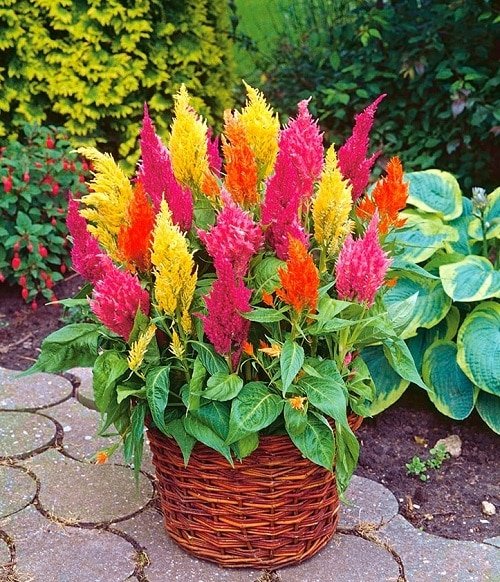
Source balconygardenweb.com
Introduction
Welcome to our comprehensive guide on celosia plant care indoors. Celosia, also known as cockscomb, is a beautiful flowering plant that can add a touch of elegance to any indoor space. With its vibrant colors and unique flower heads, celosia is a popular choice for both beginner and experienced gardeners. In this article, we will provide you with all the information you need to successfully care for your celosia plants indoors, from watering and lighting requirements to pest control and propagation techniques.
Choosing the Right Location
Lighting Requirements
Celosia plants thrive in bright, indirect light. It is recommended to place your celosia plants near a window that receives plenty of sunlight, but avoid direct sunlight as it can scorch the leaves. If you don’t have a suitable location near a window, you can also use artificial grow lights to provide the necessary light intensity.
Ensure that your celosia plants receive at least 6 hours of filtered sunlight each day. If the light is too weak, the plants may become leggy and fail to produce vibrant flowers.
Temperature and Humidity
Celosia plants prefer warm temperatures between 65 to 75°F (18 to 24°C). Avoid exposing them to temperatures below 60°F (15°C) as it can cause damage to the plant. Additionally, celosia plants enjoy higher humidity levels, so it’s beneficial to place a humidifier or pebble tray filled with water near your plants to create a more humid environment.
Avoid placing celosia plants near drafts or air conditioning vents, as the cold air can negatively impact their growth and health.
Choosing the Right Potting Mix
Celosia plants require a well-draining potting mix to thrive. A mix consisting of equal parts of peat moss, perlite, and potting soil is a good choice. This blend ensures proper moisture retention and prevents the roots from sitting in excess water, which can lead to root rot.
It’s important to use a lightweight potting mix to prevent the plant from becoming too heavy. This will make it easier to move the plant around if needed.
Watering and Fertilizing
Watering
Proper watering is crucial for celosia plants. Overwatering can lead to root rot, while underwatering can cause the plants to wither and die. The key is to keep the soil moist but not soggy.
Check the top inch of soil regularly, and if it feels dry to the touch, it’s time to water your celosia plants. Water thoroughly until the excess moisture drains out from the bottom of the pot. Discard any standing water to prevent waterlogging.
Fertilizing
During the growing season, which typically spans from spring to fall, feed your celosia plants with a balanced liquid fertilizer every two weeks. This will provide them with the necessary nutrients for healthy growth and abundant flowering.
It’s important to dilute the fertilizer according to the instructions on the packaging to avoid burning the roots. Overfertilization can cause an excessive buildup of salts in the soil, leading to nutrient imbalances and stunted growth.
Table Breakdown
| Aspect | Requirement |
|---|---|
| Light | Bright, indirect light |
| Temperature | 65 to 75°F (18 to 24°C) |
| Humidity | Higher humidity levels preferred |
| Potting Mix | Well-draining mix of peat moss, perlite, and potting soil |
| Watering | Keep soil moist, not soggy |
| Fertilizing | Feed every two weeks with balanced liquid fertilizer |
FAQ
1. How often should I water my celosia plants?
Water your celosia plants when the top inch of soil feels dry. It’s important to maintain moist but not soggy soil.
2. Can I grow celosia plants from seeds?
Yes, celosia plants can be grown from seeds. Start the seeds indoors 6-8 weeks before the last frost date, and transplant them outdoors when the soil has warmed up.
3. How can I propagate celosia plants?
Celosia plants can be propagated through stem cuttings. Take a 3-4 inch cutting from a healthy plant, remove the lower leaves, and place it in a well-draining potting mix. Keep the cutting moist until roots develop.
4. Are celosia plants prone to any pests or diseases?
Celosia plants can be susceptible to aphids, spider mites, and fungal diseases such as powdery mildew. Regularly inspect your plants and take appropriate measures to control any infestations or diseases.
5. Do celosia plants need to be pruned?
Pruning is not necessary for celosia plants, but you can remove any dead or faded flowers to encourage continuous blooming.
Conclusion
In conclusion, celosia plant care indoors requires attention to lighting, temperature, humidity, watering, fertilizing, and proper potting mix. By providing the right conditions, you can enjoy the stunning beauty of celosia plants throughout the year. Remember to choose a well-draining potting mix, water carefully, and provide adequate light and humidity. With proper care, your celosia plants will thrive and reward you with vibrant blooms that will brighten up any indoor space.